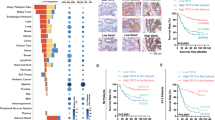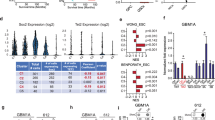Abstract
Ten eleven translocation (TET) enzymes catalyse the oxidative reactions of 5-methylcytosine (5mC) to promote the demethylation process. The reaction intermediate 5-hydroxymethylcytosine (5hmC) has been shown to be abundant in embryonic stem cells and tissues but strongly depleted in human cancers. Genetic mutations of TET2 gene were associated with leukaemia, whereas TET1 downregulation has been shown to promote malignancy in breast cancer. Here we report that TET1 is downregulated in colon tumours from the initial stage. TET1 silencing in primary epithelial colon cells increase their cellular proliferation while its re-expression in colon cancer cells inhibits their proliferation and the growth of tumour xenografts even at later stages. We found that TET1 binds to the promoter of the DKK gene inhibitors of the WNT signalling to maintain them hypomethylated. Downregulation of TET1 during colon cancer initiation leads to repression, by DNA methylation, the promoters of the inhibitors of the WNT pathway resulting in a constitutive activation of the WNT pathway. Thus the DNA hydroxymethylation mediated by TET1 controlling the WNT signalling is a key player of tumour growth. These results provide new insights for understanding how tumours escape cellular controls.
This is a preview of subscription content, access via your institution
Access options
Subscribe to this journal
Receive 50 print issues and online access
$259.00 per year
only $5.18 per issue
Buy this article
- Purchase on Springer Link
- Instant access to full article PDF
Prices may be subject to local taxes which are calculated during checkout





Similar content being viewed by others
References
Okano M, Bell DW, Haber DA, Li E . DNA methyltransferases Dnmt3a and Dnmt3b are essential for de novo methylation and mammalian development. Cell 1999; 99: 247–257.
Smith ZD, Meissner A . DNA methylation: roles inmammalian development. Nat Rev Genet 2013; 14: 204–220.
Neri F, Krepelova A, Incarnato D, Maldotti M, Parlato C, Galvagni F et al. Dnmt3L antagonizes DNA methylationat bivalent promoters and favors DNA methylation at gene bodies in ESCs. Cell 2013; 155: 121–134.
Bestor TH . The DNA methyltransferases of mammals. Hum Mol Gen 2000; 9: 2395–2402.
Lienert F, Wirbelauer C, Som I, Dean A, Mohn F, Schübeler D . Identification of genetic elements that autonomously determine DNA methylation states. Nat Genet 2011; 43: 1091–1097.
Xu GL, Bestor TH, Bourc'his D, Hsieh CL, Tommerup N, Bugge M et al. Chromosome instability and immunodeficiency syndrome caused by mutations in a DNA methyltransferase gene. Nature 1999; 402: 187–191.
Jones PA . DNA methylation and cancer. Oncogene 2002; 21: 5358–5360.
Rhee J-K, Kim K, Chae H, Evans J, Yan P, Zhang B-T et al. Integrated analysis of genome-wide DNA methylation and gene expression profiles in molecular subtypes of breast cancer. Nucleic Acids Res 2013; 41: 8464–8474.
Easwaran H, Johnstone SE, Van Neste L, Ohm J, Mosbruger T, Wang Q et al. A DNA hypermethylation module for the stem/progenitor cell signature of cancer. Genome Res 2012; 22: 837–849.
Rhee I, Bachman KE, Park BH, Jair K-W, Yen RW, Schuebel KE et al. DNMT1 and DNMT3b cooperate to silence genes in human cancer cells. Nature 2002; 416: 552–556.
Teng I-W, Hou P-C, Lee K-D, Chu P-Y, Yeh K-T, Jin VX et al. Targeted methylation of two tumor suppressor genes is sufficient to transform mesenchymal stem cells into cancer stem/initiating cells. Cancer Res 2011; 71: 4653–4663.
Gaudet F, Hodgson JG, Eden A, Jackson-Grusby L, Dausman J, Gray JW et al. Induction of tumors in mice by genomic hypomethylation. Science 2003; 300: 489–492.
Feltus FA, Lee EK, Costello JF, Plass C, Vertino PM . Predicting aberrant CpG island methylation. Proc Natl Acad Sci USA 2003; 100: 12253–12258.
Sato H, Suzuki H, Toyota M, Nojima M, Maruyama R, Sasaki S et al. Frequent epigenetic inactivation of DICKKOPF family genes in human gastrointestinal tumors. Carcinogenesis 2007; 28: 2459–2466.
Suzuki H, Watkins DN, Jair K-W, Schuebel KE, Markowitz SD, Dong Chen W et al. Epigenetic inactivation of SFRP genes allows constitutive WNT signaling in colorectal cancer. Nat Genet 2004; 36: 417–422.
Jin B, Yao B, Li JL, Fields CR, Delmas AL, Liu C et al. DNMT1 and DNMT3B modulate distinct polycomb-mediated histone modifications in colon cancer. Cancer Res 2009; 69: 7412–7421.
Tahiliani M, Koh KP, Shen Y, Pastor WA, Bandukwala H, Brudno Y et al. Conversion of 5-methylcytosine to 5-hydroxymethylcytosine in mammalian DNA by MLL partner TET1. Science 2009; 324: 930–935.
Ito S, Shen L, Dai Q, Wu SC, Collins LB, Swenberg JA et al. Tet proteins can convert 5-methylcytosine to 5-formylcytosine and 5-carboxylcytosine. Science 2011; 333: 1300–1303.
Maiti A, Drohat AC . Thymine DNA glycosylase can rapidly excise 5-formylcytosine and 5-carboxylcytosine: potential implications for active demethylation of CpG sites. J Biol Chem 2011; 286: 35334–35338.
He YF, Li BZ, Li Z, Liu P, Wang Y, Tang Q et al. Tet-mediated formation of 5-carboxylcytosine and its excision by TDG in mammalian DNA. Science 2011; 333: 1303–1307.
Neri F, Incarnato D, Krepelova A, Rapelli S, Pagnani A, Zecchina R et al. Genome-wide analysis identifies a functional association of Tet1 and Polycomb repressive complex 2 in mouse embryonic stem cells. Genome Biol 2013; 14: R91.
Haffner MC, Chaux A, Meeker AK, Esopi DM, Gerber J, Pellakuru LG et al. Global 5-hydroxymethylcytosine content is significantly reduced in tissue stem/progenitor cell compartments and in human cancers. Oncotarget 2011; 2: 627–637.
Kudo Y, Tateishi K, Yamamoto K, Yamamoto S, Asaoka Y, Ijichi H et al. Loss of 5-hydroxymethylcytosine is accompanied with malignant cellular transformation. Cancer Sci 2012; 103: 670–676.
Lian CG, Xu Y, Ceol C, Wu F, Larson A, Dresser K et al. Loss of 5-hydroxymethylcytosine is an epigenetic hallmark of melanoma. Cell 2012; 150: 1135–1146.
Yang H, Liu Y, Bai F, Zhang JY, Ma S-H, Liu J et al. Tumor development is associated with decrease of TET gene expression and 5-methylcytosine hydroxylation. Oncogene 2013; 32: 663–669.
Bacher U, Haferlach C, Schnittger S, Kohlmann A, Kern W, Haferlach T . Mutations of the TET2 and CBL genes: novel molecular markers in myeloid malignancies. Ann Hematol 2010; 89: 643–652.
Kallin EM, Rodríguez-Ubreva J, Christensen J, Cimmino L, Aifantis I, Helin K et al. Tet2 facilitates the derepression of myeloid target genes during CEBPα-induced transdifferentiation of pre-B cells. Mol Cell 2012; 48: 266–276.
Prensner JR, Chinnaiyan AM . Metabolism unhinged: IDH mutations in cancer. Nat Med 2011; 17: 291–293.
Song SJ, Ito K, Ala U, Kats L, Webster K, Sun SM et al. The oncogenic microRNA miR-22 targets the TET2 tumor suppressor to promote hematopoietic stem cell self-renewal and transformation. Stem Cell 2013; 13: 87–101.
Jin SG, Jiang Y, Qiu R, Rauch TA, Wang Y, Schackert G et al. 5-hydroxymethylcytosine is strongly depleted in human cancers but its levels do not correlate with IDH1 mutations. Cancer Res 2011; 71: 7360–7365.
Song SJ, Poliseno L, Song MS, Ala U, Webster K, Ng C et al. MicroRNA-antagonism regulates breast cancer stemness and metastasis via TET-family-dependent chromatin remodeling. Cell 2013; 154: 311–322.
Tefferi A, Pardanani A, Lim K-H, Abdel-Wahab O, Lasho TL, Patel J et al. TET2 mutations and their clinical correlates in polycythemia vera, essential thrombocythemia and myelofibrosis. Leukemia 2009; 23: 905–911.
Kosmider O, Gelsi-Boyer V, Cheok M, Grabar S, Della-Valle V, Picard F et al. TET2 mutation is an independent favorable prognostic factor in myelodysplastic syndromes (MDSs). Blood 2009; 114: 3285–3291.
Saint-Martin C, Leroy G, Delhommeau F, Panelatti G, Dupont S, James C et al. Analysis of the ten-eleven translocation 2 (TET2) gene in familial myeloproliferative neoplasms. Blood 2009; 114: 1628–1632.
Sun M, Song C-X, Huang H, Frankenberger CA, Sankarasharma D, Gomes S et al. HMGA2/TET1/HOXA9 signaling pathway regulates breast cancer growth and metastasis. Proc Natl Acad Sci USA 2013; 110: 9920–9925.
Hsu C-H, Peng K-L, Kang M-L, Chen Y-R, Yang Y-C, Tsai C-H et al. TET1 suppresses cancer invasion by activating the tissue inhibitors of metalloproteinases. Cell Rep 2012; 2: 568–579.
Kanwar SS, Yu Y, Nautiyal J, Patel BB, Majumdar APN . The Wnt/beta-catenin pathway regulates growth and maintenance of colonospheres. Mol Cancer 2010; 9: 212.
Wang H, Maurano MT, Qu H, Varley KE, Gertz J, Pauli F et al. Widespread plasticity in CTCF occupancy linked to DNA methylation. Genome Res 2012; 22: 1680–1688.
Ivanov M, Kals M, Kacevska M, Barragan I, Kasuga K, Rane A et al. Ontogeny, distribution and potential roles of 5-hydroxymethylcytosine in human liver function. Genome Biol 2013; 14: R83.
Pfeifer GP, Kadam S, Jin S-G . 5-Hydroxymethylcytosine and its potential roles in development and cancer. Epigenetics Chromatin 2013; 6: 10.
Aguilera O, Fraga MF, Ballestar E, Paz MF, Herranz M, Espada J et al. Epigenetic inactivation of the Wnt antagonist DICKKOPF-1 (DKK-1) gene in human colorectal cancer. Oncogene 2006; 25: 4116–4121.
Incarnato D, Neri F, Diamanti D, Oliviero S . MREdictor: a two-step dynamic interaction model that accounts for mRNA accessibility and Pumilio binding accurately predicts microRNA targets. Nucleic Acids Res 2013; 41: 8421–8433.
Kim D, Pertea G, Trapnell C, Pimentel H, Kelley R, Salzberg SL . TopHat2: accurate alignment of transcriptomes in the presence of insertions, deletions and gene fusions. Genome Biol 2013; 14: R36.
Trapnell C, Hendrickson DG, Sauvageau M, Goff L, Rinn JL, Pachter L . Differential analysis of gene regulation at transcript resolution with RNA-seq. Nat Biotechnol 2013; 31: 46–53.
Evellin S, Galvagni F, Zippo A, Neri F, Orlandini M, Incarnato D et al. FOSL1 controls the assembly of endothelial cells into capillary tubes by direct repression of αv and β3 integrin transcription. Mol Cell Biol 2013; 33: 1198–1209.
Krepelova A, Neri F, Maldotti M, Rapelli S, Oliviero S . Myc and max genome-wide binding sites analysis links the myc regulatory network with the polycomb and the core pluripotency networks in mouse embryonic stem cells. PLoS ONE 2014; 9: e88933.
Neri F, Zippo A, Krepelova A, Cherubini A, Rocchigiani M, Oliviero S . Myc regulates the transcription of the PRC2 gene to control the expression of developmental genes in embryonic stem cells. Mol Cell Biol 2012; 32: 840–851.
Huang DW, Sherman BT, Lempicki RA . Bioinformatics enrichment tools: paths toward the comprehensive functional analysis of large gene lists. Nucleic Acids Res 2009; 37: 1–13.
Huang DW, Sherman BT, Lempicki RA . Systematic and integrative analysis of large gene lists using DAVID bioinformatics resources. Nat Protoc 2009; 4: 44–57.
Acknowledgements
This work was supported by the Associazione Italiana Ricerca sul Cancro (AIRC) IG 2011/11982. We thank Carola Ponzetto and Riccardo Taulli for the critical reading of the manuscript.
Author information
Authors and Affiliations
Corresponding author
Ethics declarations
Competing interests
The authors declare no conflict of interest.
Additional information
Supplementary Information accompanies this paper on the Oncogene website
Supplementary information
Rights and permissions
About this article
Cite this article
Neri, F., Dettori, D., Incarnato, D. et al. TET1 is a tumour suppressor that inhibits colon cancer growth by derepressing inhibitors of the WNT pathway. Oncogene 34, 4168–4176 (2015). https://doi.org/10.1038/onc.2014.356
Received:
Revised:
Accepted:
Published:
Issue Date:
DOI: https://doi.org/10.1038/onc.2014.356
This article is cited by
-
Integrative multi-omics analysis depicts the methylome and hydroxymethylome in recurrent bladder cancers and identifies biomarkers for predicting PD-L1 expression
Biomarker Research (2023)
-
Modulation of AMPK/ TET2/ 5-hmC axis in response to metabolic alterations as a novel pathway for obesity-related colorectal cancer development
Scientific Reports (2023)
-
Hypoxia switches TET1 from being tumor-suppressive to oncogenic
Oncogene (2023)
-
TET1 is a Diagnostic and Prognostic Biomarker Associated with Immune Infiltration in Papillary Thyroid Cancer
Biochemical Genetics (2023)
-
Similar programmed death ligand 1 (PD-L1) expression profile in patients with mild COPD and lung cancer
Scientific Reports (2022)



